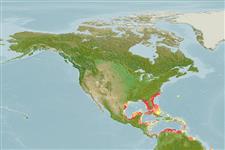Actinopterygii (ray-finned fishes) >
Ophidiiformes (Cusk eels) >
Ophidiidae (Cusk-eels) > Ophidiinae
Etymology: Ophidion: Diminutive of Greek, ophis = serpent (Ref. 45335); antipholus: Named for the brothers Antipholus (Shakespeare's The Comedy of Errors), whose identities were confused throughout the play; noun in apposition.. More on author: Robins.
Environment / Climate / Range
Ecology
Marine; benthopelagic; depth range 10 - 69 m (Ref. 81834), usually 15 - 40 m (Ref. 81834). Subtropical, preferred ?
Western Atlantic. USA (from South Carolina to Palm Beach, Florida) and Mexico (off northern coast of Yucatan).
Size / Weight / Age
Maturity: Lm ? range ? - ? cm
Max length : 21.0 cm SL male/unsexed; (Ref. 81834)
Short description
Morphology | Morphometrics
Dorsal
soft rays
(total): 111-133;
Anal
soft rays: 94 - 103;
Vertebrae: 65 - 69. This species is characterized by the following features: D 111-133 (usually 116-123); A 94-103; pectoral fin rays 18 or 19 (rarely 20 or 21); precaudal vertebrae 15-17 (usually 16), caudal vertebrae 49-53 (usually 50-52), total vertebrae 65-69 (usually 66-68); lower arm of first gill arch with 5 or 6 developed rakers; rounded head profile with mouth distinctly inferior; dorsal and ventral profiles of body nearly parallel for much of its length; unmarked body; short and unequal pelvic-fin rays, longer reaching to point directly under anterior edge of opercle (Ref. 81834).
Observed on open sand and mud bottoms (Ref. 81834). Reproductive strategy possibly similar to other members of this family featuring oviparity, with oval pelagic eggs floating in a gelatinous mass (Ref. 205).
Life cycle and mating behavior
Maturity | Reproduction | Spawning | Eggs | Fecundity | Larvae
Lea, R.N. and C.R. Robins, 2003. Four new species of the genus Ophidion (Pisces: Ophidiidae) from the western Atlantic Ocean. University of Kansas Museum of Natural History, Scientific Papers No. 31:1-9. (Ref. 81834)
IUCN Red List Status (Ref. 115185)
CITES (Ref. 94142)
Not Evaluated
Threat to humans
Harmless
Human uses
More information
Age/SizeGrowthLength-weightLength-lengthLength-frequenciesMorphometricsMorphologyLarvaeLarval dynamicsRecruitmentAbundance
ReferencesAquacultureAquaculture profileStrainsGeneticsAllele frequenciesHeritabilityDiseasesProcessingMass conversion
Tools
Special reports
Download XML
Internet sources
Estimates of some properties based on models
Phylogenetic diversity index (Ref.
82805): PD
50 = 0.5000 [Uniqueness, from 0.5 = low to 2.0 = high].
Bayesian length-weight: a=0.00102 (0.00046 - 0.00225), b=3.06 (2.88 - 3.24), in cm Total Length, based on all LWR estimates for this body shape (Ref.
93245).
Trophic Level (Ref.
69278): 3.6 ±0.7 se; Based on size and trophs of closest relatives
Resilience (Ref.
69278): High, minimum population doubling time less than 15 months (Preliminary K or Fecundity.).
Vulnerability (Ref.
59153): Low to moderate vulnerability (27 of 100) .
